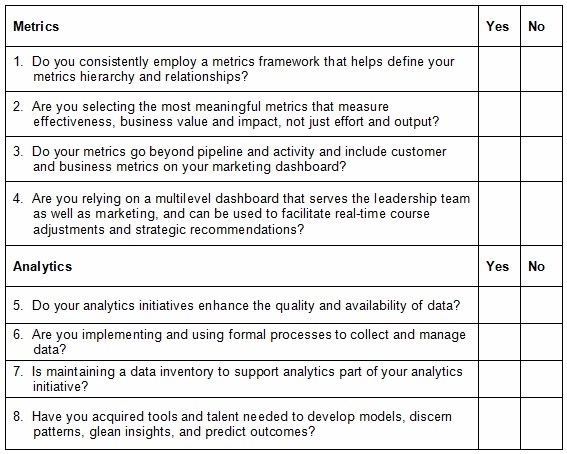At several conferences recently, I've had the opportunity to talk with a variety of B2B marketers on the topic of analytics.
During one conversation with a marketing vice-president for a B2B company, he said, "We have our metrics well in hand, we use Google Analytics and a number of other sources." Then, in another conversation, people were using the terms "analytics" and "metrics" interchangeably.
I admit to having been taken by surprise. Though metrics and analytics go hand in hand, and both are used by best-in-class (BIC) marketers to prove and improve the value of marketing, they are not the same.
So, the purpose of this article is to clarify the two concepts and provide a checklist to help you determine your team's maturity level in these two critical proficiencies.
Metrics are standards of measurement, and there are many marketing metrics, including the following:
- Activity measures related to the number of things you produce, such as the number of new blog posts or the number of events, and the associated hard and soft costs of those things
- Output measures related to the result of what you produce, such as website traffic, media mentions, and event participants
- Operational metrics, such as cost per lead and leads per rep
- Outcome metrics, such as win rate, pipeline contribution, share of preference, and share of wallet
BIC marketers select and report on outcome metrics, and they are able to create a logic chain between and among activity, output, operational, and outcome metrics.
Metrics serve as integral component of accountability. Accountability encompasses making a commitment to a particular action, accepting responsibility for completing that action, and then disclosing how well you performed against your commitment. Accountability requires metrics and measurement.
Measuring your performance may take analytics. Formulating your metrics may take analytics. But analytics is not metrics, and it doesn't require employing metrics at all.
Analytics involves applying statistics and mathematics to data in an effort to see the patterns in the data. There are many ways to use analytics in marketing. For example, you can use them to...
- Create models to help understand, monitor, and predict customer behavior, such as likelihood to defect or predisposition to purchase
- Make and optimize channel and mix decisions or to understand the impact of a campaign on sales list; and to quantify performance
Fourteen years of research conducting the Marketing Performance Measurement Study have shown us that BIC marketing teams are highly proficient in both metrics and analytics.
On the metrics front, BIC marketers select metrics that enable them to connect marketing activities and investments to business results. They employ a framework to support that effort. These elite marketers understand the value of a dashboard and develop dashboard to facilitate decisions.
On the analytics front, the BIC have conquered data capture and management and focus analytics on business questions, such as these:
- Which new markets should we pursue?
- How can we best acquire new customers?
- Which existing markets and customers should we grow?
- What new products should we develop?
- Which channels create the greatest response rate?
- Which customers are most likely to buy and which are at risk to defect?
BIC marketers are investing in building their analytical muscle. They are mastering a variety of marketing models, from segmentation, customer buying, and persona modeling... to campaign lift, attribution, and opportunity scoring models... to predisposition to purchase and customer risk models.
With that in mind, use the following self-evaluation checklist to determine how well you are doing at incorporating best-practices to take your analytics and metrics capabilities to the next level:

Metrics and analytics work hand in hand. They are important and interrelated tools that will help you prove and improve the value of marketing.
If you answered "No" to any of the metrics questions, check out one of our most popular workbooks: "It's More than Money on the Line: Creating Metrics to Measure Marketing's Effectiveness, Impact and Value."
If you answered "No" to any of the analytics questions, check out the recording of "The Creation, Care and Feeding of an Analytics Center of Excellence."




